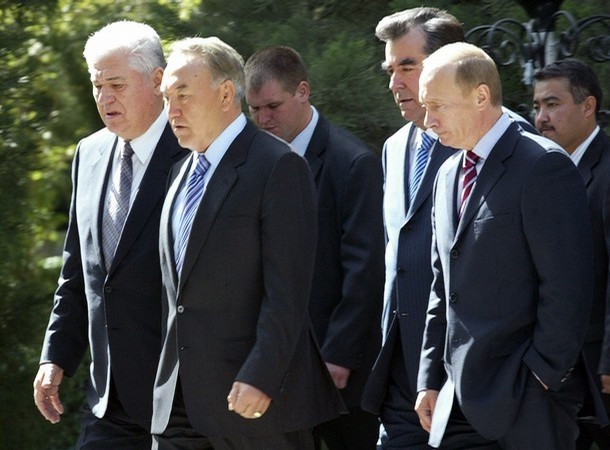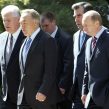
The CSTO: Missions, Capabilities, Political Ambitions
Publication: Eurasia Daily Monitor Volume: 6 Issue: 25
By:

The Collective Security Treaty Organization (CSTO), which adopted decisions to develop Collective Rapid Response Forces at a summit in Moscow on February 4 (see EDM, February 5), owes its existence to Russia’s ambition to cast itself as the leader of a political-military bloc on the Eurasian landmass.
From Russia’s perspective, the CSTO must symbolize to the outside world the continuity of Moscow’s claim to primacy in the "post-Soviet space" following, and notwithstanding, the Soviet Union’s demise. Vladimir Putin, who has described the Soviet Union’s disintegration as "the greatest geopolitical catastrophe of the 20th century," initiated the creation of the CSTO in 2002 when he was president. Russia, Belarus, Armenia, Kazakhstan, Kyrgyzstan, and Tajikistan joined that year and Uzbekistan in 2006.
The CSTO is also meant as a symbolic continuator of the Soviet-era Warsaw Treaty Organization (WTO) and a consolation prize for Russia’s loss of that political-military bloc in Central and Eastern Europe. The CSTO’s slowly-developing structure and its working procedures are broadly modeled on those of the WTO, although the new bloc’s focus has shifted to Central Asia as a "zone of Russian interests."
During the Moscow summit just held, Russian officials from President Dmitry Medvedev on down attempted to define the CSTO’s missions and, implicitly, to justify its existence beyond mere symbolism. The officials at various levels enumerated possible missions such as: deterring and repelling aggression by conventional military forces; defending the sovereignty and territorial integrity of the organization’s member countries; conducting "special operations"; and dealing with asymmetrical threats and challenges, including international terrorism, radical Islam, and other forms of "violent extremism," trans-border organized crime and drug trafficking, and even natural or technological disasters.
According to Moscow’s official discourse, most of these threats and challenges are expected to arise in Central Asia or emanate from further south–Afghanistan and the Afghan-Pakistani border area–to affect Central Asia and Russia ("threats from the south") (Itar-Tass, Interfax, February 4, 5).
Such a broad gamut of missions, however, looks crassly disproportionate to the CSTO’s own capabilities, that is, the forces earmarked specifically for the CSTO and available on call. Those forces consist of 10 battalions in Central Asia–five Russian battalions stationed in Tajikistan and another five battalions contributed in theory by Central Asian countries but based in practice permanently at home. Designated as "rapid-deployment forces," they seldom exercise together and their on-call, rapid-deployment capability is dubious.
The CSTO also lays claim to a western zone of responsibility (Belarus-Russia) and one in the South Caucasus (Russia-Armenia), each with its own "group of forces." In a more tangible sense than other CSTO countries, Armenia regards this arrangement as beneficial to itself. Yerevan welcomes the February 4 decision to create rapid response forces in Yerevan’s own frame of reference: these would provide "collective defense in the event of aggression against any CSTO member country" and deter "certain leaders who hope for a military solution to the Karabakh conflict," said General Haig Kotanjian, head of the Defense Ministry’s Strategic Studies Institute, in commenting on the Moscow summit’s decision (Interfax, February 5).
As this statement suggests, Armenia views the CSTO primarily as a conventional military actor as well as a framework for Russian protection of Armenian territorial gains against Azerbaijan. This traditional view contrasts with that of Central Asian governments, which expect the CSTO to deal with asymmetrical threats and challenges, such as those associated with terrorism, from non-state sources.
Kremlin consultant Gleb Pavlovsky regards the CSTO as potentially useful to Russia against "Georgia, an aggressive revisionist state that strives to revise borders" (Interfax, February 4). Moscow, however, has failed to elicit CSTO recognition of Abkhazia and South Ossetia following Russia’s August 2008 "coercive peace operation" (prinuzhdenie k miru) against Georgia.
"Collective peacekeeping" is among the missions that Moscow has in mind for the CSTO. Documents adopted last year at Russian initiative arrogate a "peacekeeping" role for the CSTO on the territories of member countries, even without an international mandate, while offering to participate in internationally-mandated peacekeeping operations outside CSTO countries. Such differentiation attempts to claim a leading role for Russia as peacekeeper in the CSTO’s "zones of responsibility" without international authorization.
Belarus, for one, refuses to participate in such operations, while other CSTO countries show no desire to do so. According to a statement by the Belarus Ministry of Foreign Affairs following the Moscow summit, Belarus troops may not be deployed in "hot spots" (conflict areas) on ex-Soviet territories. "Belarus law rules this out. This has never happened and will never happen," the Belarus MFA spokesman said (Interfax, February 5).




